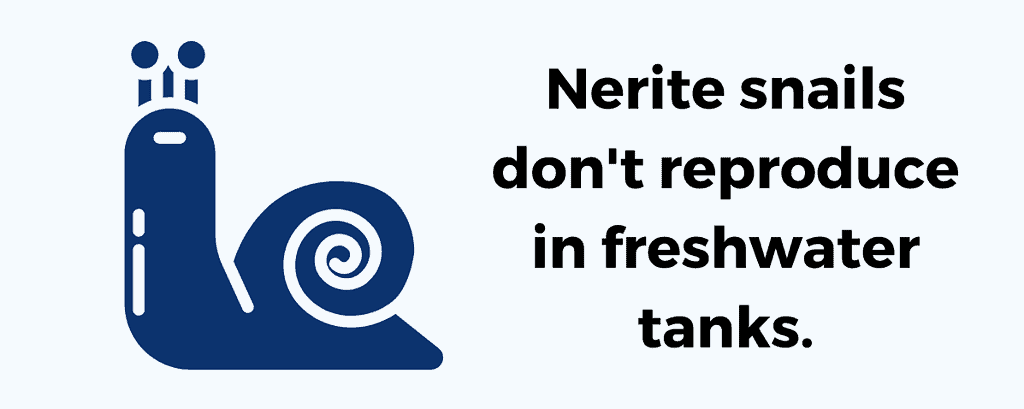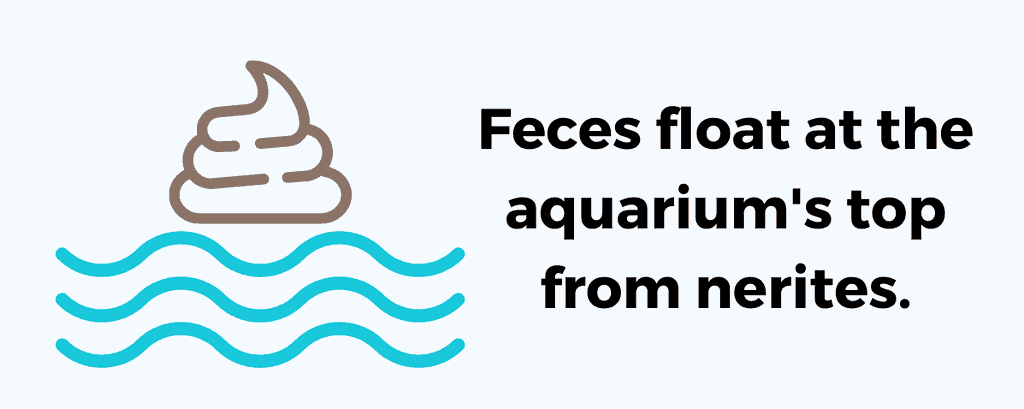Nerite snails are infamously good algae eaters in freshwater tanks.
But they are also notorious for producing a lot of waste, a tricky obstacle for new snail owners.
To know how to handle the excess waste, you first need to understand why nerite snails poop so much.
Nerite snails eat throughout the day and are continuously producing waste. When you control the amount of algae and other food they take in, you help them poop less often. Remove the extra poop before it pollutes the aquarium water. It floats at the top of the water, making cleanup easy.

Table of Contents
Why Do Nerite Snails Produce So Much Waste?

These helpful aquatic snails are renowned as voracious algae eaters. They consume dead plant matter, food waste from your fish, and all the green algae they can find.
Unlike your fish with a feeding schedule, nerites feed throughout the day. Thus, they also poop throughout the day.
Their poop is small and tends to come in a brown color range. It may be green if your snails eat lots of algae.
You will see what looks like sand or salt grains floating at the top of the tank.
Nerite snails produce about the same amount of waste as other algae eaters.
Mystery snails, for example, poop every few minutes throughout the day.
Consider getting a ramshorn snail if you want a cleaner helper in your tank. They don’t poop as often as other aquatic snails.
To some extent, high waste production is normal in your nerite snail. However, snail waste should not overwhelm the aquarium.
If you see severe spikes in ammonia or other signs of water pollution, it is probably due to overfeeding.
Managing Nerite Snail Poops and Excess Waste

Keeping all waste in the tank to a minimum is crucial to keeping your fish healthy.
When waste gets out of control, your tank is struck with high nitrite or ammonia levels.
Ammonia spikes lead to fin rot, infections, and other illnesses in freshwater fish.
Sometimes waste problems lead to harmful pH changes as well.
Aquarium snails struggle with a sudden pH change, which can soften their shells and make them sick.
Most fish owners get aquarium snails for cleaning up fish food and other kinds of plant and fish waste.
The benefits of your nerite snails are undone if there’s too much food and other kinds of waste in the tank.
Tips for Managing Waste

To help you avoid this problem, we have a few tips:
- Don’t give your snails their own meals
- Remove uneaten food after five minutes
- Keep one snail per five-gallon tank
- Perform weekly partial water changes
Snails do well without additional food. They can feed on algae, dead fish or shrimp, fish food leftovers, and aquarium plants.
Adding supplemental foods is rarely necessary.
Unless you see signs of malnutrition, trust your snail’s tank mates to produce plenty of food for them.
Don’t let food waste remain in the water for long, either.
Unless you have a snail who burrows in the substrate, letting food waste reach the bottom of the tank is a recipe for poor water conditions.
Waste builds up more slowly if the tank is big enough to accommodate your snails.
Even if your nerite is a real poop machine, they have difficulty hurting water conditions when you pick the right aquarium size and keep up with weekly water changes.
Is Nerite Snail Waste Bad for Water Conditions?

If nerite snail poop builds up over time, a wide range of problems may arise.
For one thing, ammonia may spike. This causes fin rot and other health problems in your snail’s tank mates.
Otherwise, the extra waste may create more acidic conditions in the aquarium. This is harmful to both snails and fish.
If waste problems are left unresolved for an extended period, temperatures may also be thrown out of wack.
Chemical levels, temperatures, and the pH balance in your fish tank are all critical to fish and snail health.
Keep a close eye on the water quality in the tank. Use a thermometer and keep water testing strips on hand.
When you do weekly water changes, check the parameters to be sure everything is okay.
Look out for signs of stress or illness in your fish and snails. These might be:
- Discoloration
- Stress stripes
- Lethargy
- Loss of appetite
- Floating or not moving
- Swimming sideways or upside down
- Producing no waste/too much waste
How to Reduce Waste with Diet Changes

Nerites excrete what they take in. When they overeat food, they poop more than usual.
Because of this, controlling their diet is crucial to maintaining waste production.
Nerite snails are content to live off various kinds of fish waste, green algae, and plant leaves.
Two nerite snails would thrive with this diet in a densely planted tank of 5-10 gallons.
You might see snail foods in the pet store or online. But most of the time, these are unnecessary.
Instead, stick to the feeding times your fish needs. Your snails eat the leftover food and then graze on algae and plant matter throughout the day.
These are the ideal foods for your snails and help you avoid overfeeding.
Generally, your snails won’t produce enough waste to alter the water quality in your aquarium unless you overfeed them.
Other Ways to Combat Waste Build-Up

There is only so much a fish owner can do to prevent waste production. Instead, focus your efforts on maintaining the aquarium water.
Here are some basic guidelines for keeping a clean tank:
- Do weekly water changes
- Use a good filtration system
- Spot clean as needed
Weekly water changes are essential to any freshwater fish tank, especially if you keep more than one aquatic pet.
The smaller the tank, the more frequently it needs cleaning.
The better the filtration, you may be able to clean slightly less often.
Cleaning needs depend on tank mates and the snail population as well.
Aside from the usual water changes, clean small portions of the tank as needed. This includes using a gravel vacuum to clean the substrate.
But it also includes cleaning up the tank’s sides and occasionally replacing aquarium plants.
Population Control

Another way to keep waste down is to keep only a few snails. One nerite snail per five-gallon tank is the rule of thumb.
But snails reproduce rapidly, which makes it difficult to control the population.
Fortunately, nerite snails do not reproduce in freshwater tanks. They only reproduce in brackish water.
If you do have a brackish tank and need to cut the population down, consider using loaches.
These guys will naturally prey on your snails. You need to be prepared to care for the loaches, though.
If you keep them in the snail tank at all times, they will eat all your snails. But if you re-home them, your snails will likely reproduce quickly and take over again.
How Much Waste Is Normal for Nerite Snails?

It is normal for nerite snails to poop throughout the day.
You’ll likely see a lot of feces floating at the top of your aquarium from your nerites.
You only need to be concerned if the feces are:
- White or goopy
- Impacting water quality
So long as your snails consistently produce about the same amount of waste, they are likely healthy.
White and goopy poop is a sign of illness, and this may be more dangerous to the rest of your aquarium than other waste.
Does Nerite Snail Waste Harm the Snail Itself?

In truth, snails are less picky about their water parameters than most fish.
They tolerate a huge water temperature range, whereas some fish have a range as small as a few degrees.
But nerites also feel changes in water temperature, pH, and chemical levels.
In acidic conditions, for example, a nerite will have shell problems. Their shell can soften or crack, making them more vulnerable to further health issues.
Snails sometimes get infections, too, which will change the appearance of their feces. These infections are sometimes fatal.
To prevent these problems, keep your tank as clean as possible.
This includes performing weekly water changes, using a good filtration system, and spot cleaning as needed.
These are things we do with any aquarium.
But being more mindful and closely monitoring water parameters makes a huge difference!
The Cost of Algae Control
A nerite snail aquarium is likely to show almost no algae build-up. But the cost of keeping algae in check is the appearance of extra waste.
To keep your nerite snail aquarium clean, perform consistent water changes and spot clean as needed.
Be wary of overfeeding, which contributes to the problem.
Snails don’t need supplements most of the time and do well just eating food waste and plant matter in the tank.
If you want to look into nerite snails a little more, read our article on nerite snail care.


